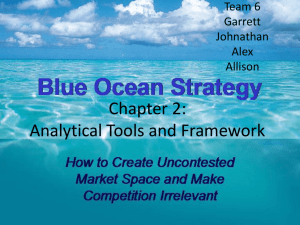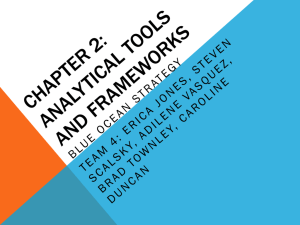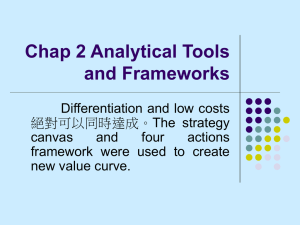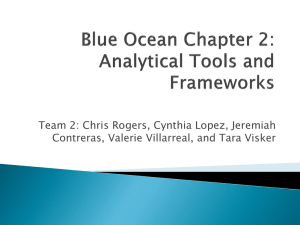Slides
advertisement
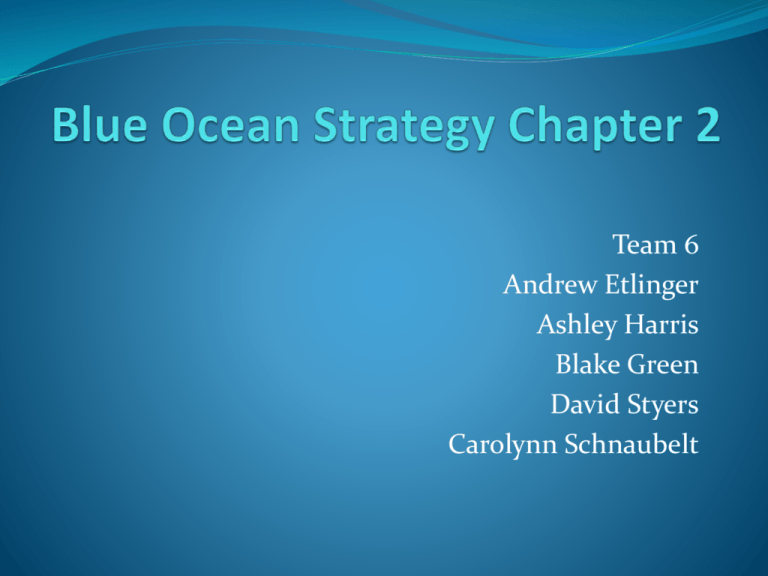
Team 6 Andrew Etlinger Ashley Harris Blake Green David Styers Carolynn Schnaubelt Analytical Tools and Frameworks Objectives Developing practical tools and frameworks to achieve a Blue Ocean with an explanation of a Strategy Canvas Making Blue Ocean strategy systematic and actionable as easy as possible by implementing the value curve Using Strategic Profiles to utilize market share The Strategy Canvas Strategy Canvas- An analytic framework that is central to value innovation and the creation of blue oceans.. A diagnostic and an action framework that helps create an effective BOS Acknowledge where the market stands and what companies are doing in it. What the prices of certain materials are at a certain period of time How companies are presenting their goods/services to the common consumer Company and product awareness Quality the product or service portrays Reputation that the company is known for Amount of density the product or service has on the consumer The diverse range of the company’s products The Strategy Canvas Value Curve- A basic component of the strategy canvas, is a graphic depiction of a company’s relative performance across its industry’s factors of competition. Strategic profiles- used to distinguish between one tier against another tier of competitors Both high and low strategic profiles share the same essential shape in its respective market place Minimize benchmarking and extensive customer research Trying to out perform your competitor will hardly help a company reach an uncontested market Instead focus on alternatives and noncustomers In the path to a BOS , competitors and customers should be in the company’s peripheral The Strategy Canvas http://philiphallenborg.files.wordpress.com/2008/02/strategy-canvas.jpg The Four Actions Framework The authors developed the four actions framework in order to reconstruct buyer value elements while crafting a new value curve. In order to create a new value curve, four questions must be answered: Which factors that the industry takes for granted should be eliminated? Which factors can be reduced well below industry standards? Which factors should be raised well above the industry standards? Which factors should be created that the industry has never offered? The Four Actions Framework http://www.aspire.com.my/002%20SA/Figure%202.png The Four Actions Framework Eliminate Often the factors that need to be cut out are ones that the companies have always competed on within the industry Some of these factors no longer have any real value or may even detract value Buyers values tend to change overtime and companies how are focused on Red Sea tactics of benchmarking fail to act on or even perceive these changes Ex: Cirque de Soleil eliminated star performers, animal shows, aisle concessions, and multiple show rings from the circus industry. The Four Actions Framework Reduce Companies need to figure out which products or service have been “overdesigned” in the race to keep up with the competition Example: Gillette Fusion v. Schick Quattro In these situations, companies over serve their customers, resulting in an increase in cost structure with no gain in return The Four Actions Framework Raise Factor that need to be raised are those that the industry forces the consumers to compromise Example: Southwest Airlines raised the level of customer service They also increased speed by creating frequent point-to-point departures and connecting midsized cities rather than having flight converge in a hub. The Four Actions Framework Create By creating new factors in a industry, companies discover new sources of value for buyers and create new demand while shifting the strategic pricing of the industry. Example: [yellowtail] created wines than were less complex and therefore appealed to a broader cross section of alcohol beverage consumers Wii Gaming system The Four Actions Framework The first two questions (eliminating and reducing) give companies the knowledge of how to lower prices compared to the competition The last two questions (raising and creating) give companies insight into how to create demand and increase buyer value The Eliminate-Reduce-RaiseCreate Grid This is the third and final tool that is a key for creating blue oceans. It not only has companies push to ask the questions of what to eliminate, reduce, raise, create, but also to act on them as well. By acting on these questions, it allows the companies to create a new value curve. Benefits from the EliminateReduce-Raise-Create Grid First of all, it pushes the company to simultaneously pursue differentiation and low cost to break the cost value trade off. Second, it flags the company that they are only focused on raising and creating, which often leads to a higher cost structure and over engineering products/services. Third, it is easily understood by all levels of management. Finally, the grid cause management to scrutinize the company more, ensuring that they will no longer make assumptions when competing. The Eliminate-Reduce-RaiseCreate Grid This is the last tool that is key in creating blue oceans Example: Yellow Tail Wine Eliminate Enological terminology and distinctions Raise Price versus budget wines Retail store involvement Aging qualities Above-the-line marketing Reduce Wine complexity Create Easy drinking Wine range Ease of selection Vineyard prestige Fun and adventure Three Characteristics of a Good Strategy Focus The company does not diffuse its efforts across all key factors Divergence It looks across alternatives instead of benchmarking competitors Compelling Tagline Clear-cut and truthful [yellow tail], Cirque du Soleil, and Southwest Airlines created blue oceans by having these three characteristics in their strategic profiles Focus The company’s strategic profile or value curve should clearly show the focus. Southwest Airlines only emphasizes three factors: friendly service, speed, and frequent point-to-point departures and by doing this it has been able to price against car transportation. Southwest’s competitors cannot match this because they invest in all the industry’s factors. Divergence You want your value curve to be different than your competitors on the strategy canvas. To create a different value curve apply the four actions of eliminating, reducing, raising, and creating. Southwest was the first to have point-to-point travel between midsize cities unlike their competitors who just went to large cities. Compelling Tagline A good tagline gives a clear message and is truthful otherwise customers will lose trust and interest. A way to test the effectiveness and strength of a strategy is to see if it contains a strong and authentic tagline. [yellow tail]’s strategic profile is clear by using the tagline: a fun and simple wine to be enjoyed every day. Reading the Value Curves Overall, the strategy canvas allows companies to examine the future in the present. If a company meets the 3 criteria: focus, divergence, and a compelling tagline; that company is on the right track to be a winner. If a company does not meet the 3 criteria and the value curve converges with its competitors the company will most likely get caught in the Red Ocean. Reading the Value Curves (cont.) When a company’s value curve has all high level factors, this is not necessarily good. The company’s market share and profitability must reflect these investments. If not, this means the company may be oversupplying their customers. When the company’s curve goes in zigzag patterns this means the company does not have a strategy and the company is based on independent sub strategies. Reading the Value Curves (cont.) Strategic contradictions are seen when a company offers a high level on one competing factor while ignoring others that support that factor. Ex. Easy to use website that moves very slow. A company must also use good competing factors. Use language that is easily understood by the customers. Conclusion of Tools and Framework Using all of the tools and analytical techniques discussed in this chapter are essential to help companies break from competition and compete in the blue ocean world.
